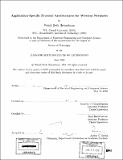Application-specific protocol architectures for wireless networks
Author(s)
Heinzelman, Wendi Beth, 1973-
DownloadFull printable version (12.94Mb)
Other Contributors
Massachusetts Institute of Technology. Dept. of Electrical Engineering and Computer Science.
Advisor
Anantha P. Chandrakasan.
Terms of use
Metadata
Show full item recordAbstract
In recent years, advances in energy-efficient design and wireless technologies have enabled exciting new applications for wireless devices. These applications span a wide range, including real-time and streaming video and audio delivery, remote monitoring using networked microsensors, personal medical monitoring, and home networking of everyday appliances. While these applications require high performance from the network, they suffer from resource constraints that do not appear in more traditional wired computing environments. In particular, wireless spectrum is scarce, often limiting the bandwidth available to applications and making the channel error-prone, and the nodes are battery-operated, often limiting available energy. My thesis is that this harsh environment with severe resource constraints requires an application-specific protocol architecture, rather than the traditional layered approach, to obtain the best possible performance. This dissertation supports this claim using detailed case studies on microsensor networks and wireless video delivery. The first study develops LEACH (Low-Energy Adaptive Clustering Hierarchy), an architecture for remote microsensor networks that combines the ideas of energy-efficient cluster-based routing and media access together with application-specific data aggregation to achieve good performance in terms of system lifetime, latency, and application-perceived quality. This approach improves system lifetime by an order of magnitude compared to general-purpose approaches when the node energy is limited. The second study develops an unequal error protection scheme for MPEG-4 compressed video delivery that adapts the level of protection applied to portions of a packet to the degree of importance of the corresponding bits. This approach obtains better application-perceived performance than current approaches for the same amount of transmission bandwidth. These two systems show that application-specific protocol architectures achieve the energy and latency efficiency and error robustness needed for wireless networks.
Description
Thesis (Ph.D.)--Massachusetts Institute of Technology, Dept. of Electrical Engineering and Computer Science, 2000. Includes bibliographical references (p. 145-154).
Date issued
2000Department
Massachusetts Institute of Technology. Department of Electrical Engineering and Computer SciencePublisher
Massachusetts Institute of Technology
Keywords
Electrical Engineering and Computer Science.